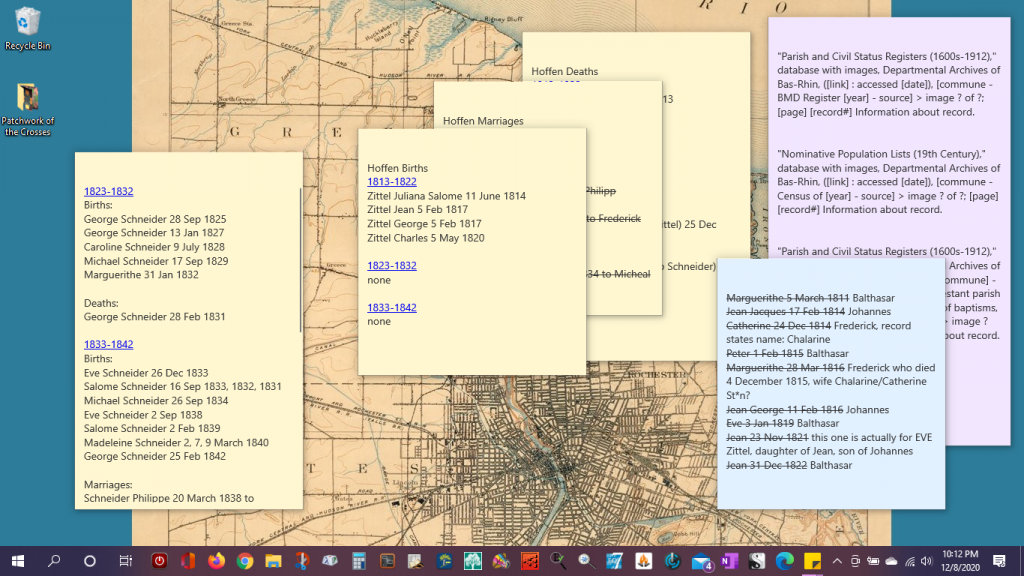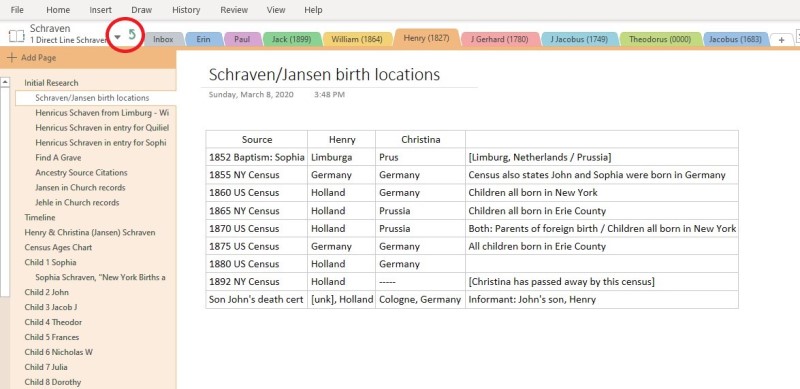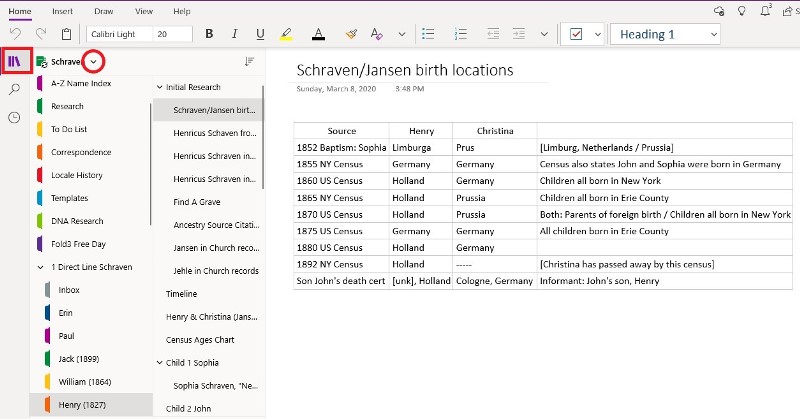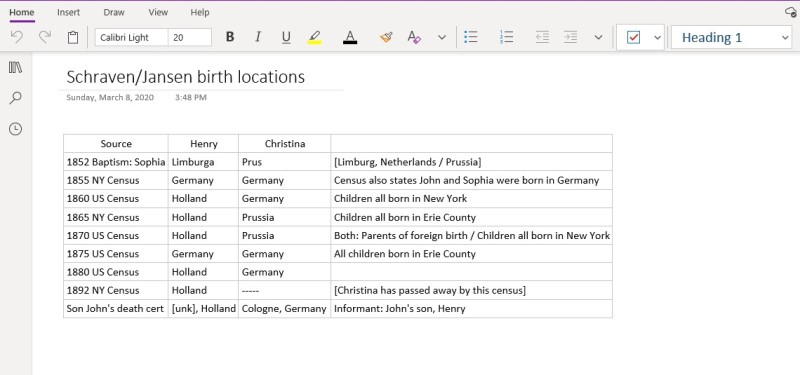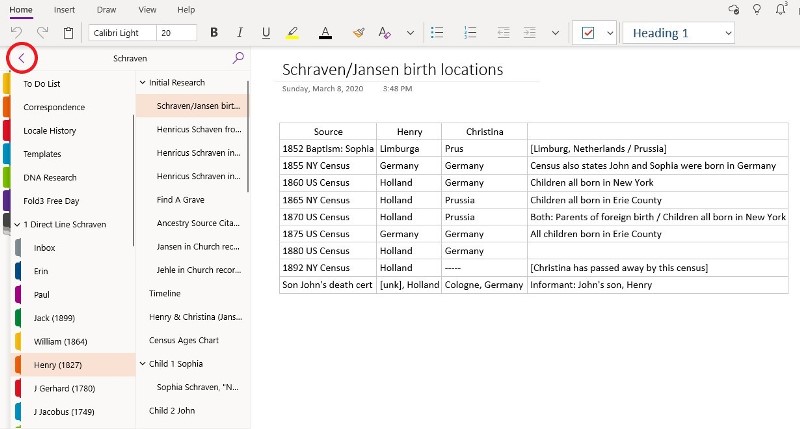In the ON Templates Section of the Surname notebooks, there is a template for a Research Plan. (A special thank you to Christine Sisko Clause for letting me borrow heavily from her original template to create mine all those years ago.) It’s rather fancy-pants and I have used it on occasion. I like using it when I am trying to solve just one problem for a person or family group. If it’s more complicated, I end using the Initial Research Page that I described in my last post. I filled out a Research Plan for you as an example using the research I did for the death date and place for Johannes Zittel.
This is what the Blank Research Plan template looks like: Blank Research Plan PDF
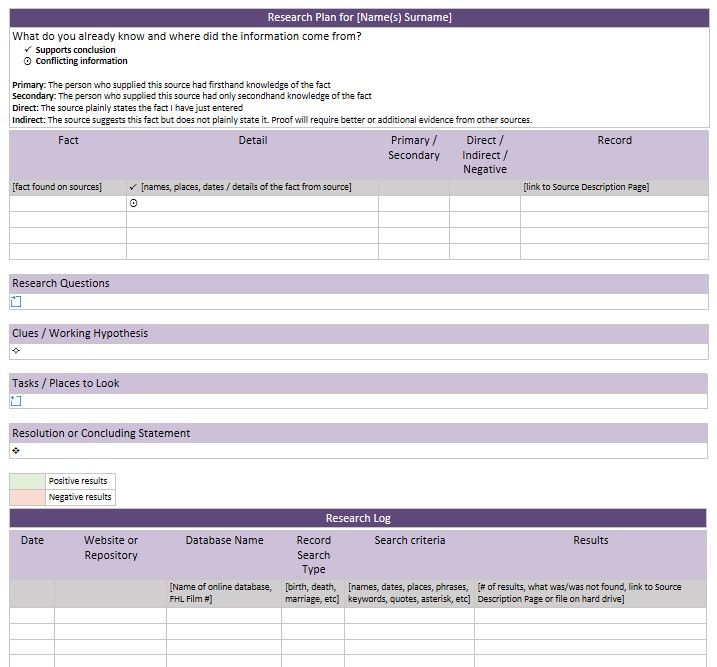
=====
On to the plan… Trees online at Ancestry had John Zittel’s death on 8 Oct 1847 and burial in St. John’s Cemetery in Sheldon, New York. But a change to the FindaGrave.com memorial I had attached to his death put that information in doubt. I did some digging and found my answers.
The template for a Blank Research Plan has some basic instructions and several different tables grouped together to complete the plan. Always start with what you know and give details from the sources you may already have acquired. I filled out the first table in the Research Plan with what I knew, the new, conflicting information and sources (documents) I got the information from.
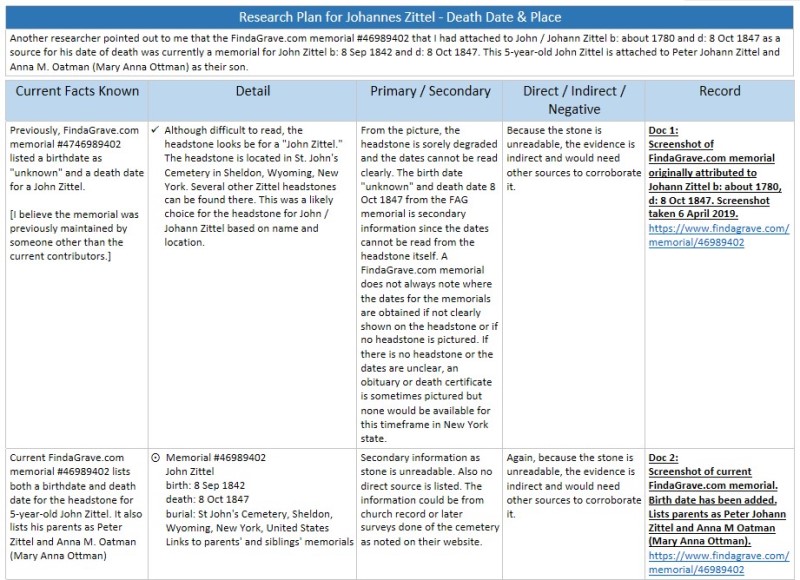
The example above shows the information I originally had and where I got it from as supporting the original conclusion. The next two lines (last line not shown in image above), detail the known conflicting information about Johannes Zittel’s death date. [As a side note: Originally the trees on Ancestry showed Johannes Zittel having the given name of “John” probably because of this FindaGrave.com memorial that is now in question. However, as I have researched more on this family in the last few months, I have discovered his given name to be Johannes.]
=====
The next three tables are for your Research Question, Clues / Hypothesis and Tasks / Places to Look (for new information).
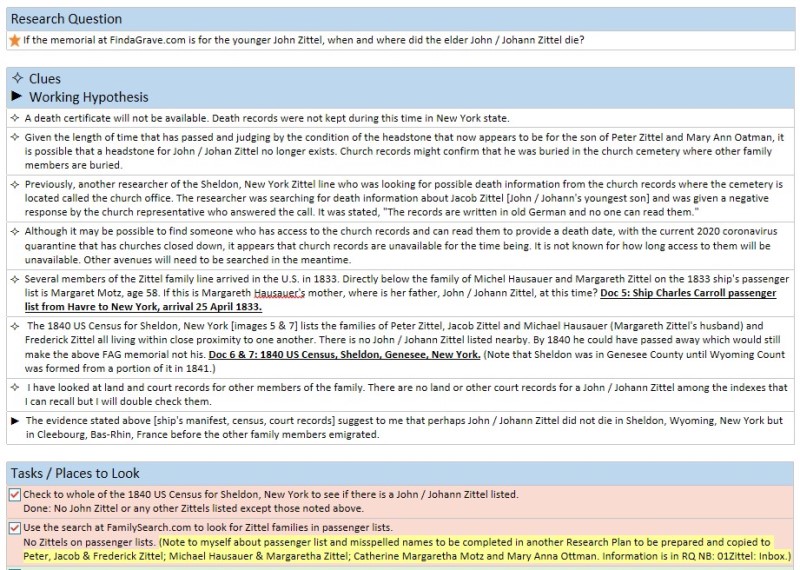
In my Research Plan, I wrote the specific information I was looking for as a Research Question. Then I detailed some thoughts about where to look for more records and other thoughts I had before I hypothesized that Johannes may have actually died in Cleebourg, France:
- Given that his wife and several children traveled without him to New York.
- The fact that I did not see him living close to family members in the 1840 US Census in Sheldon, New York.
- There are no other apparent records for Johannes in what was then Genesee County, New York.
However, I did search methodically through the records as I outlined in my Clues / Hypothesis table rather than jumping right into the Cleebourg death records just to make sure I had not missed him.
=====
Given that the conclusion is fairly straight forward, I am not going to analyze the new sources (documents) using a Source Description Template nor did I use the table for the Research Log that is included on the Research Plan template. I just put images of the sources (documents) at the bottom of the page with their source citations. (For the most part, at least.)
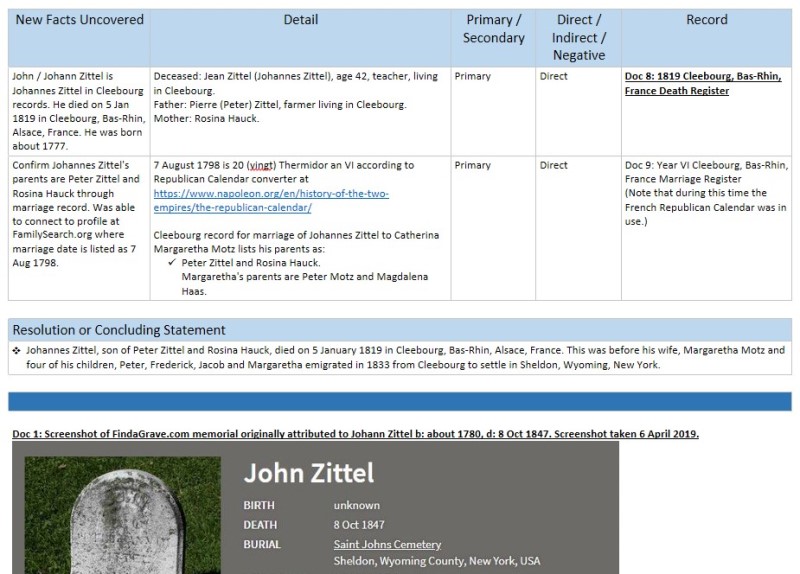
=====
Johannes Zittel died on 5 Jan 1819 in Cleebourg, Bas-Rhin, Alsace, France according to the death record I found there. To corroborate that this was indeed the right Johannes Zittel — the one married to Margaretha Motz — I then looked for their marriage record. The parents listed on the death record and marriage record for Johannes are the same so I concluded that the death record was his. A PDF of the completed Research Plan is here.
Cleebourg 1819 death record1
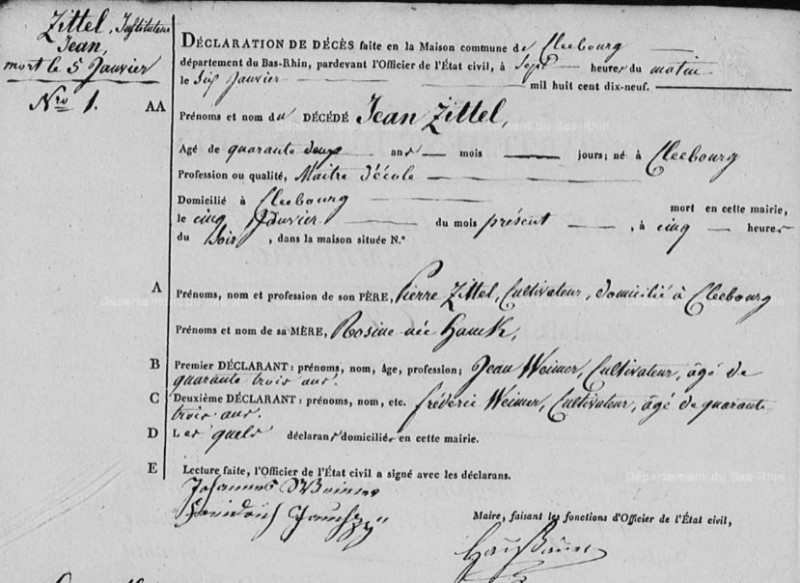
Cleebourg 1798 marriage record2
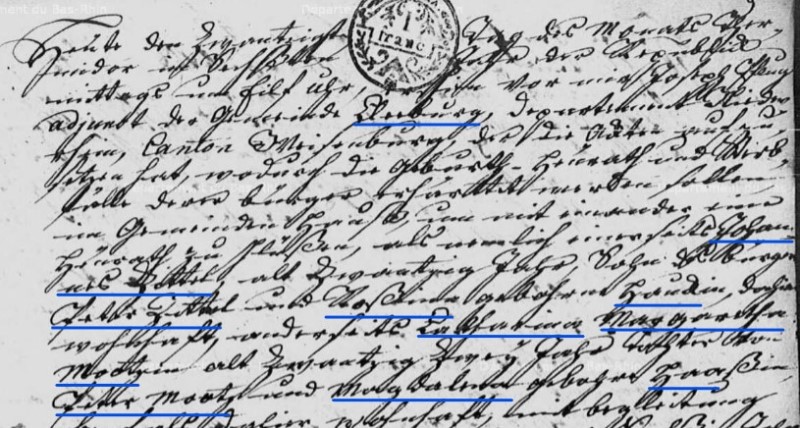
=====
No, I cannot read French nor German. Google Translate and I are becoming fast friends. Regarding the marriage record, I am trusting the person who listed the marriage date over at FamilySearch.org for Johannes Zittel’s profile. The year is correct judging by the volume I found the marriage record in, but I do not see at the top of the record where it says “vingt thermidor” which is the date of the French Republic Calendar for 7 August 17983. I am going to have someone who has more experience translating French and German records confirm the date for me.
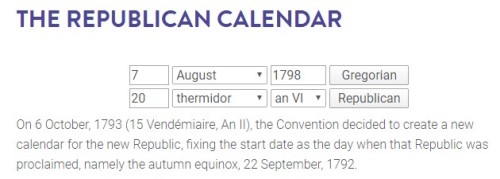
=====
My original reason for using the Research Plan in a more formal way for that genealogical problem was to document my conclusions and turn it into a PDF that could be attached to Johannes Zittel’s profile in my Ancestry tree. Because the death information is pretty straight forward, I am going to add the information with a PDF of the death record from the Bas-Rhin Archives and the citation to his profile instead. Which I am going to attempt to go do right after I upload this blog post, because I have a tendency to skip that part while chasing after more bright shiny objects and falling down numerous other rabbit holes, etc.
Until the next time,
~Erin
1 “Cleebourg Death Register – 1819” database with images, Departmental Archives of Bas-Rhin (http://archives.bas-rhin.fr/detail-document/ETAT-CIVIL-C74-P1-R56411#visio/page:ETAT-CIVIL-C74-P1-R56411-3077231 : accessed 1 May 2020, image 2 of 9 > No. 1 > 5 Jan 1819 > Entry for Johannes Zittel.
2 “Cleebourg Marriage Register – Year VI” database with images, Departmental Archives of Bas-Rhin (http://archives.bas-rhin.fr/detail-document/ETAT-CIVIL-C74-P1-R56276#visio/page:ETAT-CIVIL-C74-P1-R56276-289673 : accessed 1 May 2020, image 3 of 5 > Entry for marriage of Johannes Zittel and Catherina Margaretha Motz.
3 “The Republican Calendar” date converter app. Napoleon.org (https://www.napoleon.org/en/history-of-the-two-empires/the-republican-calendar/ : accessed 2 May 2020); converted > 7 August 1798 Gregorian calendar to French Republic calendar date of 20 thermidor an VI.
Cite This Page:
Erin Williamson Klein, “Research Plan for Johannes Zittel.” My Family History Files.com, 2 May 2020 (https://myfamilyhistoryfiles.com/research-plan/research-plan-for-johannes-zittel/ : [access date]).
Please do not copy without attribution and link back to this page.
Like this:
Like Loading...

